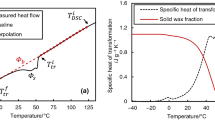Abstract
Wax crystallization processes are investigated using differential scanning calorimetry, near-infrared spectroscopy, and nuclear magnetic resonance spectroscopy. The performance of a chemical additive is assessed using calorimetry and NMR. Heat flows of model waxy oils are obtained using differential scanning calorimetry, providing the wax appearance temperature and crystallization profiles. The effect of cooling rate, wax content, asphaltene, and chemical additive on the wax appearance temperature is investigated. The wax appearance temperature increases with increasing wax contents. The wax appearance temperature decreases in the presence of chemical additive, effectively increasing the instantaneous supersaturation. Furthermore, near-infrared spectroscopy and nuclear magnetic resonance spectroscopy are utilized to determine wax appearance temperature. The NMR experiments quantify liquid and solid fractions at thermal equilibrium conditions, effectively circumventing the need for dynamic thermal techniques.






Similar content being viewed by others
Abbreviations
- h :
-
Planck’s constant 6.626 × 10−34 (m2 kg s−1)
- D:
-
Diffusion coefficient (m2 s)
- E :
-
Energy level (m2 kg s−2)
- H o :
-
External magnetic field strength (A m−1)
- I :
-
Spin (dimensionless)
- I o :
-
Integration constant (A m−1)
- M :
-
Magnetization (A m−1)
- M +0 :
-
Integration constant (A m−1)
- T :
-
Characteristic relaxation time (s)
- γ :
-
Magnetogyric ratio (A s kg−1)
- v :
-
Velocity (m s−1)
- ω :
-
Frequency (s−1)
- ▽:
-
Del operator
- x, y, z :
-
Cartesian coordinates
References
Elsharkawy AM, Al-Sahhaf TA, Fahim MA. Wax deposition from Middle East crudes. Fuel. 2000;79:1047–55.
Singh P, Fogler HS, Nagarajan N. Prediction of the wax content of the incipient wax-oil gel in a pipeline: an application of the controlled-stress rheometer. J Rheol. 1999;43:1437–59.
Wardhaugh LT, Boger DV. Flow characteristics of waxy crude oils: application to pipeline design. AIChE J. 1991;37:871–85.
Davidsen S, Hamouda A. The wax content and the wax precipitation temperature simultaneously for crude oils at pipeline pressures. SPE International Symposium on Oilfield Chemistry. Houston, Texas; 1999. p. 459–473.
Kruka VR, Cadena ER, Long TE. Cloud-point determination for crude oils. J. Pet. Technol. 1995;47:681–7.
Kok MV, Letoffe JM, Claudy P, Martin D, Garcin M, Volle JL. Comparison of wax appearance temperatures of crude oils by differential scanning calorimetry, thermomicroscopy and viscometry. Fuel. 1996;75:787–90.
Ronningsen HP, Bjorndal B, Hansen AB, Pedersen WB. Wax precipitation from North Sea crude oils: 1. Crystallization and dissolution temperatures, and Newtonian and non-Newtonian flow properties. Energy Fuels. 1991;5:895–908.
Claudy P, Letoffe JM, Neff B, Damin B. Diesel fuels: determination of onset crystallization temperature, pour point and filter plugging point by differential scanning calorimetry. Correl Stand Test Methods Fuel. 1986;65:861–4.
Hansen AB, Larsen E, Pedersen WB, Nielsen AB, Rønningsen HP. Wax precipitation from North Sea crude oils. 3. Precipitation and dissolution of wax studied by differential scanning calorimetry. Energy Fuels. 1991;5:914–23.
Jiang Z, Hutchinson JM, Imrie CT. Measurement of the wax appearance temperatures of crude oils by temperature modulated differential scanning calorimetry. Fuel. 2001;80:367–71.
Ashbaugh HS, Radulescu A, Prud’homme RK, Schwahn D, Richter D, Fetters LJ. Interaction of paraffin wax gels with random crystalline/amorphous hydrocarbon copolymers. Macromolecules. 2002;35:7044–53.
Bhat NV, Mehrotra AK. Measurement and prediction of the phase behavior of wax–solvent mixtures: significance of the wax disappearance temperature. Ind Eng Chem Res. 2004;43:3451–61.
Holder GA, Winkler J. Wax crystallization from distillate fuels. J. Inst. Pet. 1965;51:228–52.
Paso K, Kallevik H, Sjöblom J. Measurement of wax appearance temperature using near-infrared (NIR) scattering. Energy Fuels. 2009;23:4988–94.
Hoffmann R, Amundsen L. Influence of wax inhibitor on fluid and deposit properties. J Pet Sci Eng. 2013;107:12–7.
Machado ALC, Lucas EF, González G. Poly(ethylene-co-vinyl acetate) (EVA) as wax inhibitor of a Brazilian crude oil: oil viscosity, pour point and phase behavior of organic solutions. J Pet Sci Eng. 2001;32:159–65.
Taraneh JB, Rahmatollah G, Hassan A, Alireza D. Effect of wax inhibitors on pour point and rheological properties of Iranian waxy crude oil. Fuel Process Technol. 2008;89:973–7.
Zhao Y, Paso K, Sjöblom J. Thermal behavior and solid fraction dependent gel strength model of waxy oils. J Therm Anal Calorim. 2014;117:403–11.
Author information
Authors and Affiliations
Corresponding author
Rights and permissions
About this article
Cite this article
Zhao, Y., Paso, K., Norrman, J. et al. Utilization of DSC, NIR, and NMR for wax appearance temperature and chemical additive performance characterization. J Therm Anal Calorim 120, 1427–1433 (2015). https://doi.org/10.1007/s10973-015-4451-1
Received:
Accepted:
Published:
Issue Date:
DOI: https://doi.org/10.1007/s10973-015-4451-1




